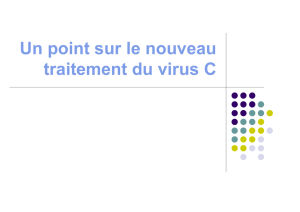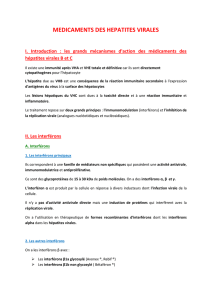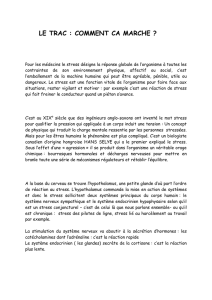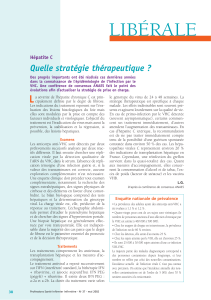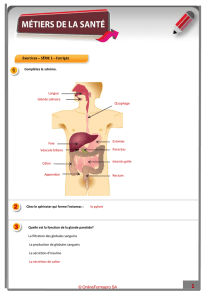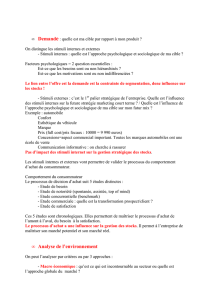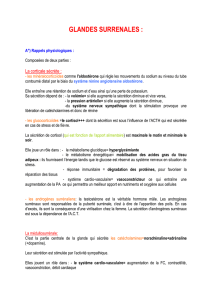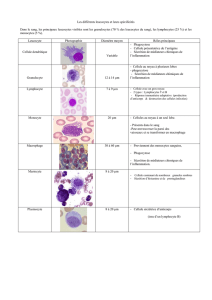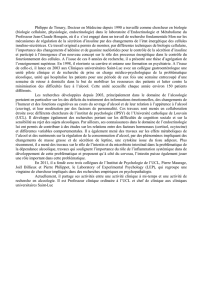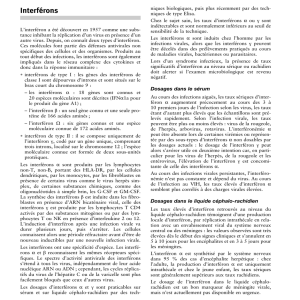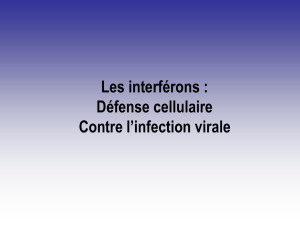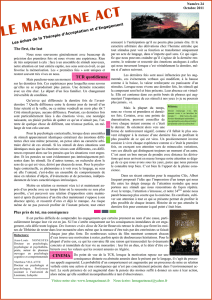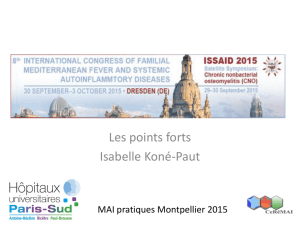Aucun titre de diapositive
publicité
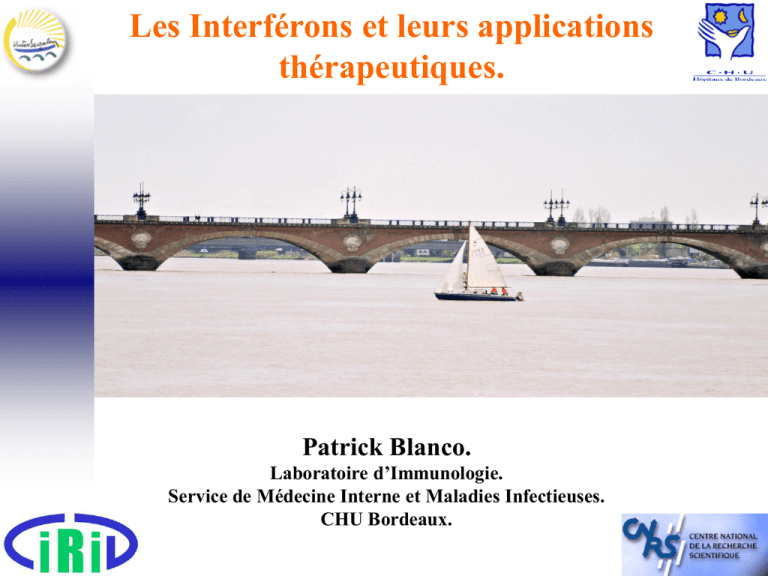
Les Interférons et leurs applications thérapeutiques. Patrick Blanco. Laboratoire d’Immunologie. Service de Médecine Interne et Maladies Infectieuses. CHU Bordeaux. 50 ans d’Histoire Rôle IFN chez homme pour traiter HBV Rôle immunologique Premier ISG cloné 2-5Asynthetase IFN et SEP (AMM) Activité anti tumorale de l’IFN chez souris IFN induit par virus Effet dans SEP IFN recombinant Essai clinique 1957 1964 1969 1970 1973 1975 Protection infection virale par IFN chez souris IFNg IFNs = une famille 1957: Isaacs et Lindenmann 1976 1977 1981 1982 IFNg cloné Activité anti-tumorale chez homme IFNg chez homme (FDA) IFNg-R cloné 1983 1986 1988 1990 1993 1997 2000 Peg-IFN IFN-R cloné IFN et HCV IFN et leucémie à tricholeucocytes TLR cloné Généralités • Type I Interférons: – 13IFNa, 1IFNb, 1IFNw, 1IFNe, 1IFNk – Protéines non glycosylées de 165-200 aa – Chromosome 9 • Type II Interféron – IFNg – 140 aa – Chromosome 6 • Type III Interférons – 3 IFNl Généralités • Récepteur Type I Interférons: IFNAR – localisation ubiquitaire – 2 chaînes associées à Tyk2 et Jak1 – Chromosome 21 • Type II Interféron: IFNGR – localisation ubiquitaire pour IFNGR1 et restreinte et régulée pour IFNGR2 – 2 chaînes associées – IFNGR1: Chromosome 6 et domaine de liaison à Jak1 – IFNGR2: Chromosome 21 et domaine de liaison à Jak2 • Type III Interférons:IFNLR PLAN Interférons de type I • • • • • Interféron de type II Stimuli/Sécrétion Signalling Rôle Implications en pathologie humaine Thérapeutique PLAN Interférons de type I • • • • • Interférons de type II Stimuli/Sécrétion Signalling Rôle Implications en pathologie humaine Thérapeutique IFN type I: Stimuli/Sécrétion • Virus, bactérie, agents chimiques, . • Toutes les cellules peuvent en sécréter mais une seule peut en sécréter de très grandes quantités et tous les IFN de type I: cellule dendritique plasmacytoïde. • Sécrétion TLR dépendante (voie endosomale) ou indépendante (voie non endosomale): RIG-I (RNA helicase), MDA5 RIG: retinoid-acid-inducible gene I MDA5: melanoma differenciation-associated antigen 5 HUMAN DC SUBSETS IFN de type I IFN type I: Stimuli/Sécrétion IFN de type I IFN type I: Stimuli/Sécrétion IFN type I: Stimuli/Sécrétion PLAN Interférons de type I • • • • • Interféron de type II Stimuli/Sécrétion Signalling Rôle Implications en pathologie humaine Thérapeutique IFN type I: Signalling PLAN Interférons de type I • • • • • Interféron de type II Stimuli/Sécrétion Signalling Rôle Implications en pathologie humaine Thérapeutique Rôles • Rôle anti-viral direct: ISG – 2’5’-oligoadenylate synthetases – RibonucleaseL (RNASEL) – MxA protein: GTPase se fixant aux nucléocapsides –… Rôle anti-viral direct: ISG Rôle anti-viral direct: ISG Rôles • Activation immunité innée: cellules NK, CD • Activation immunité adaptative: lymphocytes T CD8+ • Action anti-proliférative • Action pro-apoptotique PLAN Interférons de type I • • • • • Interféron de type II Stimuli/Sécrétion Signalling Rôle Implications en pathologie humaine Thérapeutique Sécrétion inappropriée d’interféron-alpha dans maladie auto-immune: anomalie génique • Syndrome d’Aicardi-Gouttière • Encéphalopathie: anomalies SB, calcifications, élévation d’IFN-alpha (LCR et sérum). • Différentes maladies (forme néonatale versus forme tardive) et différentes mutations. • Différentes anomalies géniques retrouvées. Sécrétion inappropriée d’interféron-alpha dans maladie auto-immune: anomalie génique Sécrétion inappropriée d’interféron-alpha dans maladie auto-immune: exemple du SLE • Taux d’IFN-alpha sont élevés ds le sérum et dans tissus lésés. Hooks JJ et al. N Engl J Med. 1979;301:5-8. Preble OT et al. Science. 1982;216:429-31. • Signature IFN à l’échelle des gènes. Bennett L et al. J Exp Med. 2003;197:711-23. Kirou K et al. Arthritis Rheum. 2004;50:3958-67 • Modèles murins: majoration de la maladie avec IFN-alpha et amélioration en bloquant activité IFN-alpha. Mathian A et al. J Immunol. 2005;174(5):2499-506. Santiago-Raber ML et al. J Exp Med. 2003;197(6):777-88 IFN type I: Pathologie humaine SLE P Blanco et al. Science. 2001 Conséquences de cette sécrétion inappropriée d’IFN-alpha. • Dendritic cells: – Activation – Survival – Ag presentation • T cells – – – – Activation Cross-priming Th1 deviation Chemokine R • B cells: – Activation – Ig Switching – Ag presentation – B1 cell expansion • Tissues: – upregulation of MHC and chemokines Causes of inappropriate type I interferon secretion: a partially solved key issue. • At the genetic level: – Trisomy of the type I IFN gene. – Single polymorphism in IFN-related genes (IRF5 and Tyk2). – TLR polymorphism. Zhuang H et al. Arthritis Rheum. 2006;54(5):1573-9. Sigurdsson S et al. Am J Hum Genet. 2005;76(3):528-37. Graham RR et al. Nat Genet. 2006;38(5):550-5 Hur JW et al. Tissue Antigens. 2005;65(3):266-70. Berghofer B et al. J Immunol. 2006;177(4):2088-96 • Immune complexes-mediated type I interferon secretion: Ronblom et al. Arthritis Rheum. 2006 Feb;54(2):408-20. – TLR-dependent. – TLR-independent. Sécrétion inappropriée d’interféron-alpha dans maladie auto-immune: anomalie génique Herpes Simplex Virus Encephalitis in Human UNC-93B Deficiency Armanda et al. Science 2006. Herpes simplex virus-1 (HSV-1) encephalitis (HSE) is the most common form of sporadic viral encephalitis in western countries. Its pathogenesis remains unclear, as it affects otherwise healthy patients and only a small minority of HSV-1–infected individuals. Here, we elucidate a genetic etiology for HSE in two children with autosomal recessive deficiency in the intracellular protein UNC-93B, resulting in impaired cellular interferon- /ß and - antiviral responses. HSE can result from a single-gene immunodeficiency that does not compromise immunity to most pathogens, unlike most known primary immunodeficiencies. Other severe infectious diseases may also reflect monogenic disorders of immunity. PLAN Interférons de type I • • • • • Interféron de type II Stimuli/Sécrétion Signalling Rôle Implications en pathologie humaine Thérapeutique Thérapeutique • Utilisé pour ses propriétés antivirales • Utilisé pour ses propriétés antiprolifératives • Utilisé pour ses propriétés immunorégulatrices Thérapeutique: effet anti-viral. Thérapeutique: effet immuno-régulateur. Intramuscular interferon beta-1a therapy initiated during a first demyelinating event in multiple sclerosis. CHAMPS Study Group. BACKGROUND: Treatment with interferon beta has been shown to help patients with established multiple sclerosis, but it is not known whether initiating treatment at the time of a first clinical demyelinating event is of value. METHODS: We conducted a randomized, double-blind trial of 383 patients who had a first acute clinical demyelinating event (optic neuritis, incomplete transverse myelitis, or brain-stem or cerebellar syndrome) and evidence of prior subclinical demyelination on magnetic resonance imaging (MRI) of the brain. After initial treatment with corticosteroids, 193 patients were randomly assigned to receive weekly intramuscular injections of 30 microg of interferon beta-1a and 190 were assigned to receive weekly injections of placebo. The study end points were the development of clinically definite multiple sclerosis and changes in findings on MRI of the brain. The trial was stopped after a preplanned interim efficacy analysis. RESULTS: During three years of follow-up, the cumulative probability of the development of clinically definite multiple sclerosis was significantly lower in the interferon beta-1a group than in the placebo group (rate ratio, 0.56; 95 percent confidence interval, 0.38 to 0.81; P=0.002). As compared with the patients in the placebo group, patients in the interferon beta-1a group had a relative reduction in the volume of brain lesions (P<0.001), fewer new or enlarging lesions (P<0.001), and fewer gadolinium-enhancing lesions (P<0.001) at 18 months. CONCLUSIONS: Initiating treatment with interferon beta-1a at the time of a first demyelinating event is beneficial for patients with brain lesions on MRI that indicate a high risk of clinically definite multiple sclerosis. Thérapeutique: effet immunorégulateur (mécanisme d’action). • Engagement of the type I interferon receptor on dendritic cells inhibits T helper 17 cell development: role of intracellular osteopontin. Immunity. 2008 Jul;29(1):68-78. • The type I IFN induction pathway constrains Th17-mediated autoimmune inflammation in mice. J Clin Invest. 2008 May;118(5):1680-90. Thérapeutique: effet anti-prolifératif. • Utilisé dans hémopathies: LMC, Leucémies à tricholeucocytes, myélome • Utilisé dans protocoles d’immunothérapies: mélanome, cancer du rein. Thérapeutique: effet anti-prolifératif. Prognostic significance of autoimmunity during treatment of melanoma with interferon. N Engl J Med. 2006 Feb 16;354(7):709-18. • BACKGROUND: Immunotherapy for advanced melanoma induces serologic and clinical manifestations of autoimmunity. We assessed the prognostic significance of autoimmunity in patients with stage IIB, IIC, or III melanoma who were treated with high-dose adjuvant interferon alfa-2b. METHODS: We enrolled 200 patients in a substudy of a larger, ongoing randomized trial. Blood was obtained before the initiation of intravenous interferon therapy, after 1 month of therapy, and at 3, 6, 9, and 12 months. Serum was tested for antithyroid, antinuclear, anti-DNA, and anticardiolipin autoantibodies, and patients were examined for vitiligo. RESULTS: The median duration of follow-up was 45.6 months. Relapse occurred in 115 patients, and 82 patients died. The median relapse-free survival was 28.0 months, and the median overall survival was 58.7 months. Autoantibodies and clinical manifestations of autoimmunity were detected in 52 patients (26 percent). The median relapse-free survival was 16.0 months among patients without autoimmunity (108 of 148 had a relapse) and was not reached among patients with autoimmunity (7 of 52 had a relapse). The median survival was 37.6 months among patients without autoimmunity (80 of 148 died) and was not reached among patients with autoimmunity (2 of 52 died). In univariate and multivariate regression analyses, autoimmunity was an independent prognostic marker for improved relapse-free survival and overall survival (P<0.001). CONCLUSIONS: The appearance of autoantibodies or clinical manifestations of autoimmunity during treatment with interferon alfa-2b is associated with statistically significant improvements in relapse-free survival and overall survival in patients with melanoma. PLAN Interférons de type I • • • • • Interféron de type II Stimuli/Sécrétion Signalling Rôle Implications en pathologie humaine Thérapeutique IFN-gamma: Stimuli-Sécrétion • Initialement décrit comme anti-viral. • Chromosome 12 • Produit essentiellement par les L.T CD4+ (Th1), L.T CD8+, NK – En réponse à gd nombre de stimuli bactérien, inflammatoire …. – Rôle essentiel de l’IL12 et IL18 comme inducteur d’IFN-gamma • Produit par APCs • Récepteur exprimé par toutes les cellules nucléées. IFN-gamma: Stimuli-Sécrétion PLAN Interférons de type I • • • • • Interféron de type II Stimuli/Sécrétion Signalling Rôle Implications en pathologie humaine Thérapeutique Signalling • Récepteur fonctionnel = 2 IFNg R1 (90kd, Chromosome 6, récepteur au ligand) + 2 IFNg R2 (62kd, chromosome 21, transduction du signal). • Pas d’association entre les 2 chaînes en l’absence d’IFNg Signalling PLAN Interférons de type I • • • • • Interféron de type II Stimuli/Sécrétion Signalling Rôle Implications en pathologie humaine Thérapeutique Rôles • Stimulation réponse immunitaire cellulaire (réponse de type TH1). • Augmentation des molécules de CMH. • Sécrétion IFN-beta par fibroblastes. • Activation de l’activité des macrophages: rôle essentiel pour lutte contre agents infectieux intracellulaires. Rôles Rôles PLAN Interférons de type I • • • • • Interféron de type II Stimuli/Sécrétion Signalling Rôle Implications en pathologie humaine Thérapeutique Pathologies humaines: déficits • Anomalies dans le gène codant pour R. IFNget susceptibilité à développer ds tuberculoses. Transmission autosomale récessive. Mutations décrites pour IFNg R1 et pour IFNg R2. • Anomalies acquises: anticorps anti-IFNg . Pathologies humaines: déficits Pathologies humaines: déficits Acquired predisposition to mycobacterial disease due to autoantibodies to IFNgamma. J Clin Invest. 2005 Sep;115(9):2480-8. • Genetic defects in the IFN-gamma response pathway cause unique susceptibility to intracellular pathogens, particularly mycobacteria, but are rare and do not explain mycobacterial disease in the majority of affected patients. We postulated that acquired defects in macrophage activation by IFN-gamma may cause a similar immunological phenotype and thus explain the occurrence of disseminated intracellular infections in some patients without identifiable immune deficiency. Macrophage activation in response to IFN-gamma and IFNgamma production were studied in whole blood and PBMCs of 3 patients with severe, unexplained nontuberculous mycobacterial infection. In all 3 patients, IFN-gamma was undetectable following mitogen stimulation of whole blood, but significant quantities were detectable in the supernatants of PBMCs when stimulated in the absence of the patients' own plasma. The patients' plasma inhibited the ability of IFNgamma to increase production of TNF-alpha by both autologous and normal donor PBMCs, and recovery of exogenous IFN-gamma from the patients' plasma was greatly reduced. Using affinity chromatography, surface-enhanced laser desorption/ionization mass spectrometry, and sequencing, we isolated an IFN-gammaneutralizing factor from the patients' plasma and showed it to be an autoantibody against IFN-gamma. The purified anti-IFN-gamma antibody was shown to be functional first in blocking the upregulation of TNF-alpha production in response to endotoxin; second in blocking induction of IFN-gamma-inducible genes (according to results of high-density cDNA microarrays); and third in inhibiting upregulation of HLA class II expression on PBMCs. Acquired defects in the IFN-gamma pathway may explain unusual susceptibility to intracellular pathogens in other patients without underlying, genetically determined immunological defects. Pathologies humaines: surexpression PLAN Interférons de type I • • • • • Interféron de type II Stimuli/Sécrétion Signalling Rôle Implications en pathologie humaine Thérapeutique Traitement • IMUKIN® interféron gamma-1 b humain recombinant • Imukin est indiqué dans la réduction de la fréquence des infections graves chez les patients atteints de granulomatose septique chronique • Imukin est indiqué dans la réduction de la fréquence des infections graves chez les patients atteints d'ostéopétrose maligne sévère CONCLUSIONS
